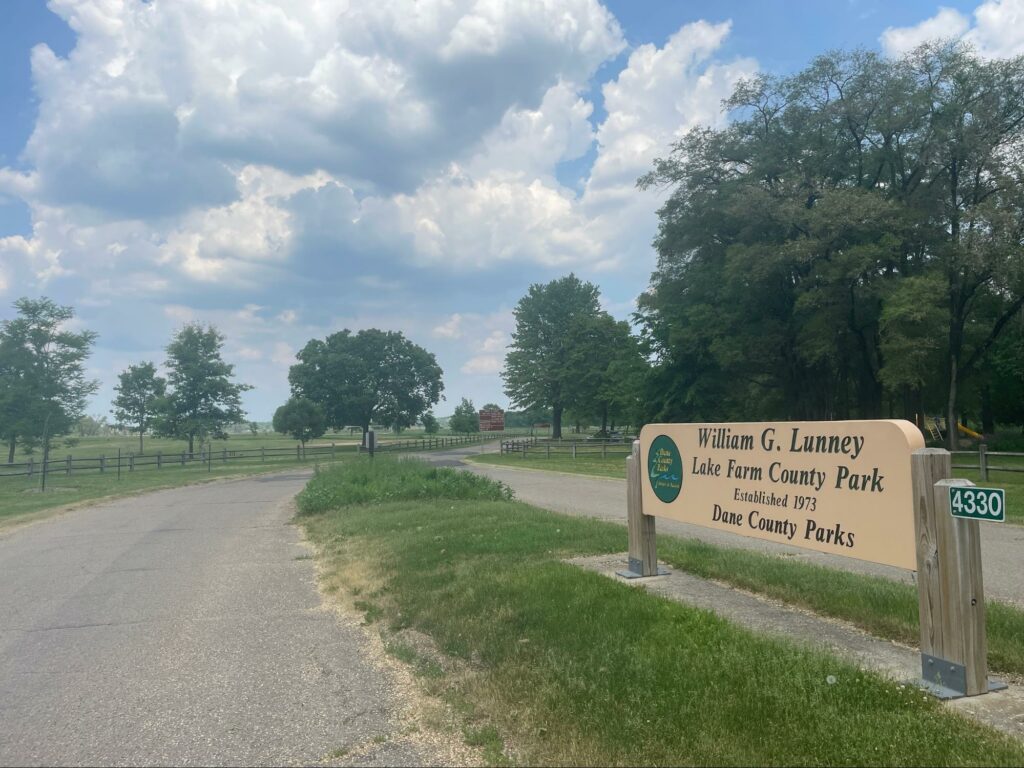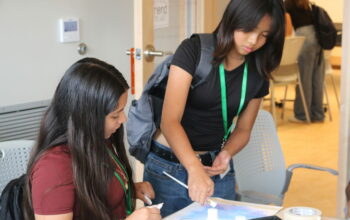
Growing community practices culture of connection to nature — and each other
When I first met Alex Britzius, his sandy blonde hair was pulled back in a low ponytail and his feet were bare. Moving smoothly over small stones and roots, he led families, mine included, down Picnic Point trail to the nature connection workshop he was leading with his partner, Heather Hutchinson.
It was summer in Madison. Pleasantly hot and sunny, trees bursting with foliage. My two young boys meandered off into the woods while my then-husband and I hustled to chase them down. Britzius and Hutchinson led us to a fire circle where primitive crafts and tools lay on the ground: baskets, arrows, wood pieces and woven cords. Toddlers traced lines in the dirt with sticks while older kids picked up the tools and crafts made from trees, shrubs and stones.
As Hutchinson offered explanations about the craftsmanship, Britzius showed us the technique for fire-by-friction. Swiftly, he miraculously produced burning embers with nothing but rope, wood and tinder. In less than a half an hour, they had managed to create a welcoming atmosphere that encouraged curiosity and sensory exploration, where the adults were lining up to see if they could make fire with sticks and the kids were wondering how they could make rope from bark.
This workshop in summer 2015 was among the first that their organization, the Wild Harvest Nature Connection, offered in the Madison area. Leading a variety of experiences outdoors including foraging, toolmaking, exploring, mapping, fort-building and storytelling, their organization has since grown to include 10 to 12 mentors guiding outings for all ages. Experiences change with the seasons and include weekly homeschooling groups, one-day workshops, summer camps and a program for adults that spans years.
“We go out into nature and we identify what’s there, what traits and qualities,” Britzius said in a recent interview. “We explore, play, observe and experience...but we also involve our emotions and empathy. We discover new connections through journaling or talking with another person.”
He said curiosities often provide common ground for deepening connection between people and to the natural world. “A kid who is really interested in weaving rope might be connected with a mentor who knows a lot about the specific trees that offer rope making material or an adult who knows a lot about weaving,” he said.
This mentorship model is foundational for the Wild Harvest Nature Connection and part of what separates nature connection from environmental education. According to Britzius, both approaches share passion for conservation and the practice of observation. But he says that while environmental education focuses on observed information and action in service to the natural world, nature connection focuses on “relationships that foster personal, environmental and cultural healing. It’s an active community building, a philosophy of connection and a practice of being with ourselves, each other and nature in a regenerative and sustainable way.”
Into the Woods at Lake Farm County Park

This spring, a group called Wild Explorers, comprised of children between the ages of 7 and 11, met at Lake Farm County Park. The 12 kids, in gear fit for mountain exploration, would spend the next six hours outside under the supervision of Weslie and Donelle, their adult mentors.
After unstructured arrival time, Donelle led an opening greeting circle before the kids’ caregivers left for the day. The circle gave everyone a chance to say hello, become mindful of their senses, share observations and make a loose plan. Standing on snow patches and frozen grass, the group sang a nature song and shared what they were grateful for: “sliding on ice; my bed; hearing red-wing blackbirds again” to start. There were long moments of silence where everyone stood or sat with the sun on their faces, listening to the birds that had just returned after winter.
After the unhurried circle and a snack, the kids headed toward the woods with full backpacks on, stopping to goof around on a patch of ice. Weslie and Donelle followed behind. Undirected, the kids changed course when they spotted a massive forest of reeds, extending over two feet above their heads. This was too cool to pass by. One by one they disappeared, rustling into the reeds while the mentors looked on.
This unstructured slow-paced interaction with the natural world can do wonders not just for adults, but for kids who are struggling with mental health, according to Meg Barrow, another Wild Harvest mentor.
Working as a pediatric occupational therapist, Barrow said she was seeing many kids in kindergarten or younger struggling, but without a diagnosed condition to explain it. She found herself asking, “Why are so many kids facing anxiety, depression and unregulated systems? What was missing?”
“From a physiological perspective, our sense of belonging, our connection to food, our sense of place and rhythm: all of our sensory perception systems are nature-based operating systems,” she said.
Combine a lack of connection with an overwhelming amount of interaction with screens and technology, and unregulated systems can result, she said. Like Britzius, she believes that with a deeper connection to the wildness within and in our natural world, we can restore deeper connections that are essential for well-being.
Wild Harvest’s practice to restore these connections is a culmination of both co-founders’ backgrounds. Heather’s experience as a social worker led her to the Weaving Earth Center for Relational Education and to the work of herbalists Julie McIntyre and Stephen Buhner. Britzius has a degree in environmental education, but found himself seeking arenas that circled back to his fascination with Tom Brown Jr.’s “The Tracker,” a book he’d read growing up that teaches: “to live with the least disruption of the earth, to revere what we took from the woods....to expand our senses and awareness.” He also credits Jon Young, an author and leader in the field of nature-based education, as a mentor who differentiates between nature information, nature recreation, nature connection and deep nature connection.
Expanding the senses and awareness is something that Britzius and other mentors practice within their groups but also recommend for everyone.
The core practice of nature connecting in this way is “sit spot.” According to Britzius, establishing a designated place outdoors to sit and observe nature and welcome your experience is one of the building blocks of connection. Some days you may hear birds you didn’t hear the day before or see the snow melting off branches.
“Finding your sit spot does not have to be an elaborate getaway,” he said.
“It could be a chair waiting outside your front door,” Britzius said. “It could be five minutes or two hours. Just setting aside time to observe nature. It’s about softening into the intention to go and be present to whatever is present.”





